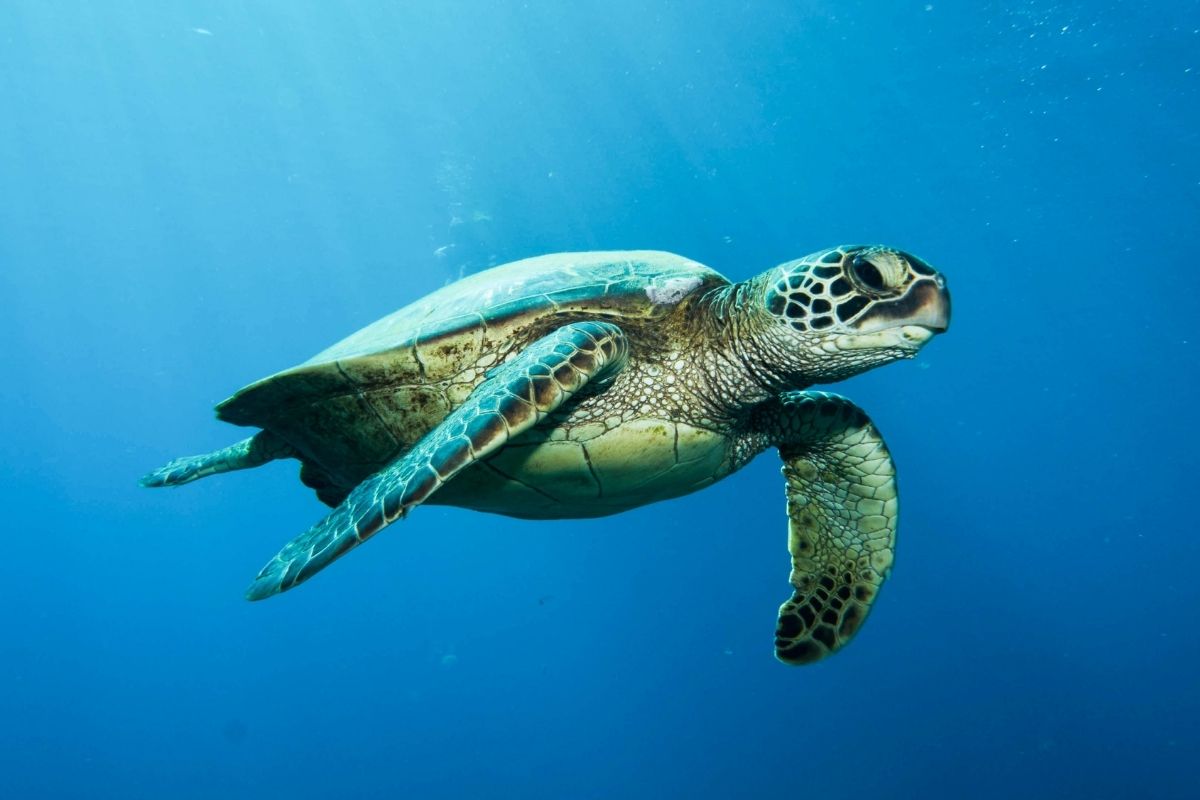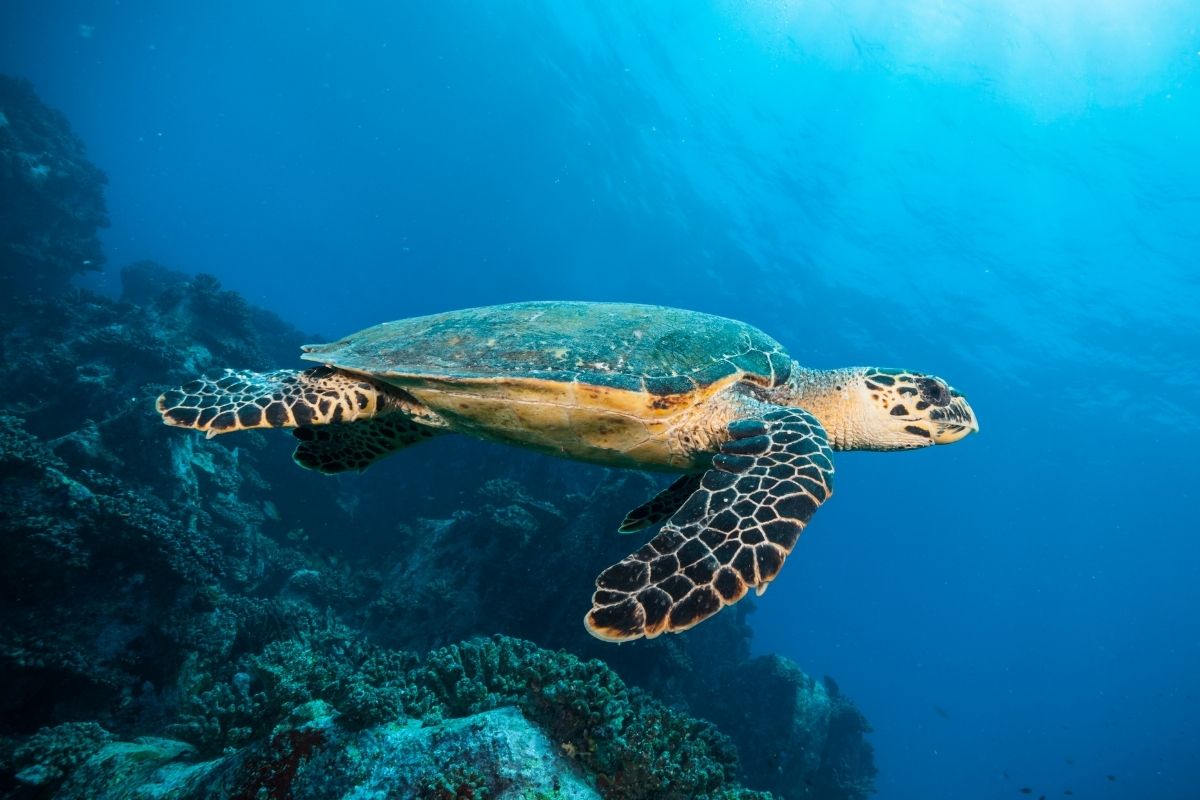Migration sees animals travel from one place to another in search of food, a place to breed, or better temperature conditions. While some animals have massive migration ranges, others don’t travel very far at all.

Some turtles do migrate, especially sea turtles. This sees them traveling for better food sources or to find an island to lay eggs. Other turtles don’t migrate and prefer to hibernate when the weather gets cold.
Turtle migration is complex and fascinating. Take a look at this guide to learn more.
Do Turtles Migrate?
There are many species of turtle found across the world, from the aquatic to the semi-aquatic to the terrestrial. This has led to a diverse range of habits and habitats. While some turtles do migrate, others are happy in one place.
Some turtles migrate and will travel immense distances at certain times of the year. Sea turtles, in particular, are known for their migration habits, which cause them to travel across the globe to lay their eggs.
The box turtle, a land turtle, doesn’t migrate. Instead, it stays happily in its own territory. A box turtle is likely to spend its entire life within 250 yards of the nest in which it was born.
Similarly, not all turtles hibernate, although a lot of them do. Hibernation occurs during the colder months when food sources are scarce and staying warm is harder.
As the temperatures drop, the turtle becomes sluggish. It will often find a place either on land or in the water to bury itself. It will nap here until rising temperatures kick-start the immune and metabolic system.
Hibernation and migration often occur for the same reason: to avoid cold winter temperatures.
Because of this, turtles tend to do one or the other. Either hibernate to escape the effects of the chill or migrate to warmer waters and avoid the cold altogether.
The Reasons Turtles Migrate
There are three main causes for migration: food, nesting, and warmth. A turtle will typically migrate if it’s in search of food, looking for a place to lay eggs, or hoping to avoid cold winter waters.
Like all migrating animals, a turtle undertakes this journey to get from a place that doesn’t meet its needs to a place that does.
The exact reason for migration can even vary from species to species.
The loggerhead sea turtle will migrate to find itself a suitable nesting site.
When the juveniles have hatched, they’ll then travel across the ocean to find waters that can support their growth. Once they’ve reached maturity, they’ll return to the nesting site and lay their own eggs.
The leatherback sea turtle is known for how far it migrates to feed. Leatherback sea turtles have one of the largest migration ranges on Earth, traveling up to 10,000 miles to find their jellyfish dinner.
The snapping turtle doesn’t have quite the same massive migration range, but they do travel to find better nesting grounds or new food sources.
For the snapping turtle, migration can be motivated by external factors affecting their current home.
Other examples of migration include red-eared slider turtles. If their habitat becomes too crowded and they can’t find a mate, the red-eared slider might search for somewhere else to live.
This isn’t seasonal migration but migration in search of something better.
What Species Of Turtle Migrate?

Not all turtles migrate, with some preferring to stay in small ranges and hibernate during the winter months.
Sea turtles are the most prolific migrating turtle species, often traveling large distances at multiple times of the year.
Turtles that migrate include:
- Green sea turtles
- Loggerhead sea turtles
- Leatherback sea turtles
- Olive ridley sea turtles
- Kemp’s ridley sea turtles
- Flatback sea turtles
- Hawksbill sea turtles
- Common snapping turtles
- Painted turtles
How Do Migrating Turtles Know Where To Go?
Migration is a pretty fascinating thing because it typically involves animals returning to the same site every year. And while humans might find their way by landmarks and compasses, navigating underwater is a tricky task.
Impressively, many turtles migrate to the same spots for generations and can find their way even if they’ve never been there before.
For animals, migration is often defined as a seasonal movement. It occurs in a cycle. A turtle will migrate when the season calls for it. So, how do turtles know when to go?
Changing temperatures and currents can often indicate to a sea turtle that it’s time to migrate.
It’s also thought that the pineal gland may play a role, particularly with the leatherback turtle. This species has a pink spot on top of the head, which might allow light to reach the brain.
When the number of light changes to indicate longer or shorter days, the turtle understands it’s time to migrate.
What causes migration is often based on environmental changes. But how, exactly, do turtles know where to go?
The answer is… no one is quite sure. In many ways, sea turtle migration remains mysterious.
It’s thought that sea turtles migrate based on the Earth’s magnetic field. The relative strength of the magnetic field across the Earth might cause reactions within the sea turtle, which tells them where to go.
This might be done by magnetic induction, a chemical reaction, or the formation of magnetic crystals.
It will take some more research before scientists understand exactly what guides sea turtles on their journeys across the ocean.
When turtles are traveling to their nesting sites, whatever shows them the way is known as natal homing.
Natal homing refers to when an animal returns to its birthplace to reproduce. This can lead to many generations of species all emerging from the same area.
As with migration, there are several theories as to how natal homing occurs.
What Time Of Year Do Turtles Migrate?
Different sea turtles migrate at different times of the year. When they travel will depend on the reason for the movement and where they’re traveling from.
Some sea turtles will travel depending on the food source. They’ll travel north in the warmer summer months, where food is abundant. They’ll return south to the warmer waters in the cold winter months.
The temperatures will also affect when a sea turtle migrates for the breeding season. Sea turtles lay their eggs many times during the year, depending on the species.
For example, green sea turtles in French Guiana nest from March to June. Meanwhile, the Indian Ocean Hawksbill sea turtle will typically mate from September to February.
It’s highly dependent on species and the location of the nesting site.
Where Do Turtles Go When They Migrate?

There’s no single area that turtles choose to migrate to. Even within a species, different populations will choose to migrate to different places.
And while some of them will travel great distances over long periods of time, others will stick to a smaller range and return home when finished feeding.
Below are some migration routes of turtle populations:
Some populations of green sea turtles travel all the way from the coast of Brazil to Ascension Island in the South Atlantic Ocean. This far-flung island provides the female turtles with a quiet place to lay her eggs.
The journey is roughly 1,490 miles, and the female leaves once her eggs have been laid.
The hawksbill sea turtle is highly migratory. They prefer to stick to coastal areas, where their sponge food source is more common.
Hawksbill will travel all over the place to get food before returning to the island of their birth come mating season.
The loggerhead sea turtle is found in the Mediterranean Sea, as well as the Atlantic, Pacific, and Indian Oceans. With a large distribution area, their migration patterns can often cross all over the place.
Loggerhead turtles born in Japan might travel all the way to Mexico before returning to Japan to breed. Other loggerhead turtles swim to Greece when it’s breeding season and make a nest on Zakynthos.
Another species with a large range is the leatherback turtle. These feed on jellyfish and follow a migration pattern to find the best food.
The Pacific leatherback turtle might travel across the ocean from Indonesia to California to find the best jellyfish to snack on.
Migrating turtles are born in many places around the globe and migrate to even more places. Because of this, it’s impossible to say exactly where turtles migrate to. They simply go wherever they need to be.
How Far Do Turtles Go When They Migrate?
Some turtles will move thousands of miles away from their birthplace.
How far the turtle travels during migration depends on the species, where they’re going, and why they’re traveling. And as with the destination, how long the journey takes varies from population to population.
What is certain is that turtles can travel some pretty incredible distances! Pacific leatherbacks might travel upwards of 6,000 miles in search of food. This takes them all the way from Indonesia to the coast of California.
One leatherback was tracked 12,774 miles traveling from Indonesia to Oregon. All in all, a leatherback might travel upwards of 10,000 miles every year following various migration routes.
And the leatherback isn’t the only turtle with a big migration range. A loggerhead born in Japan might then swim 8,000 miles to get to Baja, California, in Mexico. And then return to Japan when it’s old enough to breed.
A green sea turtle has been tracked traveling almost 2500 miles from the Indian Ocean Chagos Islands to Somalia on the coast of East Africa.
But not all turtles migrate quite so far. The flatback sea turtle is only found around the coast of Australia, the Tropic of Capricorn, and Papua New Guinea. When it migrates, it doesn’t move any great distance from these areas.
Of course, some turtles don’t migrate at all. So, the migration range of the sea turtle can be anywhere from over 10,000 miles to no miles.
Frequently Asked Questions
Do Turtles Migrate In A Group?
Sea turtles spend most of their time alone and often travel alone. However, they tend to travel at similar times during breeding periods to ensure successful mating.
How Far Do Hawaiian Green Turtles Migrate?
The Hawaiian green sea turtle, known as the Honu, is a popular sight on the shores of Hawaii. They travel around 1,200 miles every year, from the main Hawaiian islands to the Northwestern Hawaiian Islands.
